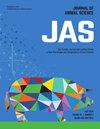Machine learning models reveal Saccharomyces yeasts are associated with poor piglet growth in early development.
IF 2.7
2区 农林科学
Q1 AGRICULTURE, DAIRY & ANIMAL SCIENCE
引用次数: 0
Abstract
Modern swine production relies on consistent growth rates across individuals to maximize efficiency and earnings, but a subset of piglets are born small and grow slowly. Nutrition and management practices can augment growth of slow growers but there remains a substantial portion of piglets that never reach their full growth potential. Traditionally, in-feed antibiotics were administered to enhance growth but with limitations on use, alternatives are needed. Emerging evidence suggests a role for bacterial members of the gut microbiome in growth, but fungal members have been largely overlooked. Yeasts have been used in the swine industry to improve health and growth, but a limited number of species have been utilized, and study results are mixed. Here, we use ITS2 sequencing to profile the mycobiome of piglets at two timepoints in early development, postnatal days 14 (D14) and 21 (D21), just before weaning. Pigs were classified as either good or poor growers, with pigs below the 40th percentile of ADG labeled as poor growers, while those above the 60th percentile were labeled as good growers. A total of 27 samples from good-growers were analyzed from D14 (n=27), 27 from poor-growers at D14 (n=27), 29 from good-growers at D21 (n=29), and 28 from poor-growers at D21 (n=28). Machine learning algorithms and differential abundance analyses were applied to identify fungi associated with both growth categories. At D14, Saccharomycetes yeasts are moderately predictive of poor growth, with the yeast genera Pichia, Lodderomyces, Clavispora, more abundant in poor growers than in good growers. Wallemia is significantly more abundant in good growers than in poor growers at D21. Additional fungi were associated with good and poor growth but data were sparse and further large scale studies are needed to verify these observations. Together, these results contribute to our understanding of the role of the mycobiome in piglet growth and suggest that the reduction of yeasts in early development may improve performance across the weaning transition and beyond.机器学习模型显示,酵母菌与仔猪早期发育不良有关。
现代养猪生产依赖于个体间一致的生长速度,以最大限度地提高效率和收益,但一小部分仔猪出生时个头小,生长缓慢。营养和管理措施可以促进生长缓慢的仔猪的生长,但仍有相当一部分仔猪从未达到其全部生长潜力。传统上,在饲料中添加抗生素是为了促进生长,但由于使用限制,需要替代品。新出现的证据表明,肠道微生物群中的细菌成员在生长中起着重要作用,但真菌成员在很大程度上被忽视了。酵母已被用于养猪业,以改善健康和生长,但已利用的品种数量有限,研究结果好坏参半。在这里,我们使用ITS2测序来分析仔猪在早期发育的两个时间点,即出生后14天(D14)和21天(D21),就在断奶之前。生猪被分为良好生猪和不良生猪,低于平均日增重第40百分位的生猪被标记为不良生猪,而高于第60百分位的生猪被标记为良好生猪。共分析了D14的27个良好种植者样本(n=27), D14的27个差种植者样本(n=27), D21的29个好种植者样本(n=29), D21的28个差种植者样本(n=28)。应用机器学习算法和差异丰度分析来识别与这两种生长类别相关的真菌。在D14时,酵母菌对生长不良有一定的预测作用,毕赤酵母属、Lodderomyces、Clavispora等酵母菌属在较差的种植者中比在良好的种植者中数量更多。在D21,良好种植者的瓦利姆病明显比差种植者的瓦利姆病丰富。其他真菌与良好和不良生长有关,但数据很少,需要进一步的大规模研究来验证这些观察结果。总之,这些结果有助于我们理解真菌组在仔猪生长中的作用,并表明在早期发育中减少酵母可能会提高断奶过渡期及以后的生产性能。
本文章由计算机程序翻译,如有差异,请以英文原文为准。
求助全文
约1分钟内获得全文
求助全文
来源期刊

Journal of animal science
农林科学-奶制品与动物科学
CiteScore
4.80
自引率
12.10%
发文量
1589
审稿时长
3 months
期刊介绍:
The Journal of Animal Science (JAS) is the premier journal for animal science and serves as the leading source of new knowledge and perspective in this area. JAS publishes more than 500 fully reviewed research articles, invited reviews, technical notes, and letters to the editor each year.
Articles published in JAS encompass a broad range of research topics in animal production and fundamental aspects of genetics, nutrition, physiology, and preparation and utilization of animal products. Articles typically report research with beef cattle, companion animals, goats, horses, pigs, and sheep; however, studies involving other farm animals, aquatic and wildlife species, and laboratory animal species that address fundamental questions related to livestock and companion animal biology will be considered for publication.
 求助内容:
求助内容: 应助结果提醒方式:
应助结果提醒方式:


